Flying Ferrari
A slippery speedster debuts in America
Panthera exterior




Deposits have been placed for 10 of the first airplanes, certified under experimental exhibition rules, with some of the checks dating back to 2019; 50 more deposits are on the books for the FAR Part 23 version that should follow in 2022. It’s surprising that most of these orders were placed by pilots who’d never even sat in the airplane, let alone flown it. Now that’s a sign of a compelling design.
The Panthera looks like it’s going 200 knots just sitting on the ramp. Its all-composite airframe has been optimized for low drag, so there’s little frontal area and great attention to detail when it comes to fit and finish. Starting at the front, you can see the tight cowling and smallish engine cooling inlets, which feed ram air into a massive plenum to maximize cooling. The airplane’s 260-horsepower Lycoming IO-540 also has tuned Inconel exhaust stacks for improved combustion efficiency and lower noise profiles. Its titanium landing gear assemblies are light, yet strong, and Beringer wheels also were chosen for their light weight.
A look inside






But the most remarkable aspect of the landing gear is the gear door arrangement. Most general aviation retractables make do with one, maybe two gear doors per wheel. Pipistrel put four doors on each main gear and three on the nosewheel assembly. That’s a total of 11 doors, which must be some kind of record. Look at them at the right angle, and the doors’ angular shapes resemble origami creations. And instead of the doors being the sharp-edged, single, flat pieces of aluminum we’re accustomed to seeing, these have beveled interior surfaces. When the gear retract, the doors close absolutely flush with the underside of the wing. When they extend, all those doors create a lot of drag. More about this shortly.
The cabin doors—there are three of them, including an aft passenger door—are equally well fitted and have passive rubber seals. With the doors shut, those seals and the flush fit translate into a quiet cabin. But it’s the seats that catch the eye. They’re fixed in a reclined position in keeping with the mandate to minimize the fuselage’s cabin height and frontal drag, and the demonstration airplane I flew had textured, black-and-red leather seats. Once in your seat, the view out front depends on your height, because the seats don’t adjust vertically. I’m 5 feet 10 and during taxi, takeoff, and in the landing flare I could just make out the tarmac ahead. A shorter person would have a view more like that of a taildragger. A thick centerpost can also interfere with forward vision.
The panel evokes that of a light jet. The Garmin avionics include dual G3X Touch primary/multifunction displays with split-screen capability, GTN 750Xi and 650Xi navcoms, a GMC 307 autopilot, a Mid-Continent standby attitude indicator, and more. The landing gear and flap controls are glareshield-mounted, and their position indicators flash when the gear or flaps are in transit. The emergency gear extension crank is beneath an armrest panel, and the BRS ballistic parachute handle is next to your head, on the centerpost.
An earlier Panthera prototype had a 210-horsepower Lycoming IO-390 engine, which Pipistrel intended to use with auto fuel. I flew an IO-390-equipped Panthera in 2015 during a visit to Pipistrel’s factory in Slovenia, and it didn’t seem underpowered. But mogas certification never came for the IO-390, so the switch was made to the more powerful IO-540, which can burn both avgas or 93-octane, ethanol-free mogas.
For this article, I flew with Andy Chan, COO of Right Rudder Aviation at the Inverness, Florida, airport and the Panthera’s only U.S. dealer. Inverness has a 5,000-foot runway and I’ll bet we used 2,000 feet of that—and a lot of right rudder—to lift off and clear the standard 50-foot obstacle. The initial climb rate on our 85-degree day settled at 1,300 fpm while at the VY of 100 knots; cruise climb is 130 to 140 knots. Before long we were at 6,500 feet, where it was 61 degrees Fahrenheit (approximately ISA +10-degree Celsius conditions) and set up to answer the burning question: Is this really a 200-knot airplane?
Power was brought up to max continuous, fuel flow hit 13 gph, and the G3X calculated a true airspeed of 193 knots. Chan said that at the airplane’s posted normal or recommended cruise power setting, true airspeed runs around 183 knots, with an 11.5-gph fuel burn at 8,500 feet. Chan said under ideal conditions you could cruise as high as 194 to 198 knots, but that fuel burn would reach the 14 to 16 gph range. Even so, Pipistrel itself touts a maximum speed of 203 KTAS.
Whether it’s 187, 194, or 198 knots, the issue is that the Panthera’s VNO is 175 knots, and its VNE is 205 knots indicated. So powered up, that slippery airplane can quickly pick up speed with even slight nose-down pitch. It happened to me. While cruising at 160 knots, I nosed over to recapture a target altitude and the Panthera headed deep into the yellow arc. Redline was only seconds away. This airplane doesn’t have speed brakes, but it certainly needs them.
All this means that descent and approach planning should be done well before reaching the terminal area or airport pattern. Chan said that those 11 gear doors serve as good stand-ins for speed brakes, and extending the landing gear (it takes 10 seconds)—as well as extending the flaps—can help scrub off speed. Quite true, but there’s a complication: Both VLE and VFE are 106 knots. Depending on your airspeed, it could take a while for the airplane to slow to those limits using engine power alone. The Panthera builds speed quickly and is reluctant to shed it.
That said, on final approach, with 18 inches of manifold pressure, gear down, and flaps at their maximum 45-degree deflection, you’ll realize the recommended reference airspeed of 75 to 85 knots. Hold it off, wait for the chirp, let the trailing-link landing gear do their magic, and you’re down in style.
The story goes that the airplane was designed at Pipistrel founder and CEO Ivo Boscarol’s request. He wanted a four-seat, 200-knot airplane that could carry four people 1,000 nm, nonstop. It appears that U.S. pilots want the same kind of performance, and with the added attraction of a price that’s hundreds of thousands of dollars less than those for new Cirrus and Bonanza airplanes. Order an experimental-exhibition version right now and you’ll wait a year for delivery. For a Part 23-certified Panthera ($800,000) deliveries should begin in 2022. Extras like long-range fuel tanks ($60,000), oxygen, air conditioning, and other options will drive prices up, and the euro’s performance against the dollar is another factor.
Pipistrel has earned a stellar reputation as a manufacturer with a heavy emphasis on light singles focusing on the training and recreational markets. In keeping with its commitment to ecologically friendly designs, some of them were the first electrically powered trainers brought to market. One branch of the company, Pipistrel Vertical Solutions, is working on an eVTOL cargo-hauler, the Nuuva.
So yes, Pipistrel is even planning a hybrid-electric variant of the Panthera, one that pairs a Rotax 915iS with an electric motor, will do 212 knots, and have a price starting at $800,000. Yet another Panthera concept would use electric and hydrogen power.
A small, 250-employee company tucked away in a small town in a chunk of the former Yugoslavia seems to be busting out of its niche and setting a new trajectory for general aviation.
Email [email protected]



